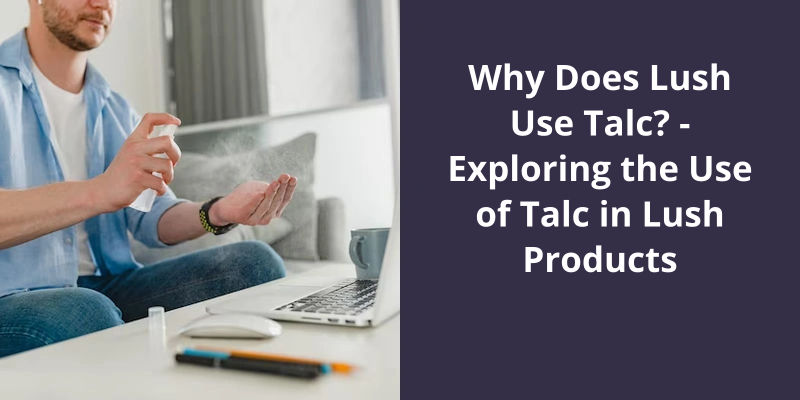Lush uses talc in its products for a variety of reasons. Talc is known for its softening and absorption properties, which come in handy for certain cosmetics and self-care products. Products such as deodorants, soaps, face powders and bath bombs benefit from the use of talc as it helps in providing a smooth application and in absorbing excess oils. Moreover, Lush takes care to ensure the talc it uses is ethically sourced, making it a safe ingredient for their products. Despite some controversy attached to talc due to its natural presence near asbestos in the earth, Lush reassures its customers of using only talc that is carefully mined and certified to be free from asbestos.

Why Do Cosmetic Companies Use Talc?
Talc is a naturally occurring mineral that’s found in rock formations all around the world. It’s a soft, white, powdery substance that’s composed of magnesium, silicon, and oxygen. Due to it’s unique properties, talc has been used for centuries in a variety of applications, including cosmetics.
Talc has a very fine and gentle texture, which makes it ideal for adding to other powders and creams.
Caking can occur when a product is exposed to humidity or heat, causing it to become clumpy and difficult to apply. Talc helps prevent this by absorbing excess moisture and keeping the product in a consistently powdery form. This makes it easier for consumers to use and ensures that the product will last longer.
Talc can also be used to make facial makeup opaque. When talc is added to a foundation or concealer, it can help to create a more even skin tone. This is particularly valuable for people who’ve uneven skin tones or other blemishes that they want to conceal.
This tactile experience is part of what makes cosmetic products so attractive to consumers.
As long as customers continue to demand high-quality cosmetics, talc will remain an important part of the industry.
The Safety Concerns Surrounding Talc and It’s Potential Links to Cancer.
- The International Agency for Research on Cancer (IARC) has classified talc that contains asbestos as “carcinogenic to humans.”
- Talc that’s free from asbestos is classified as “not classifiable as to carcinogenicity in humans” by the IARC.
- The American Cancer Society (ACS) acknowledges the potential link between talcum powder and ovarian cancer, but states that more research is needed to confirm the association.
- The National Cancer Institute (NCI) states that the evidence linking talcum powder to cancer is “unclear and inconsistent.”
- Juries have awarded billions of dollars in damages to women who’ve claimed that talcum powder caused their ovarian cancer.
- Johnson & Johnson, the largest talc product manufacturer, has faced thousands of lawsuits regarding the safety of it’s talc-based products.
- In 2020, Johnson & Johnson announced that it would discontinue the sale of talc-based baby powder in the United States and Canada due to declining demand and ongoing litigation costs.
Despite growing concerns over it’s safety, talc continues to be a popular ingredient used in a wide range of consumer products. Companies across various industries rely on talc for it’s unique properties, and it’s affordability makes it an attractive option for those looking to minimize production costs. However, recent studies and lawsuits have highlighted the potential health risks associated with talc, raising questions about whether companies should continue to use it in their products.
Why Do Companies Still Use Talc?
Despite recent concerns regarding the safety of talc, it’s use in cosmetic and personal care products remains prevalent. Some studies have suggested a link between the use of talc-based products and an increased risk of ovarian cancer, which has led to lawsuits against companies such as Johnson & Johnson. However, the evidence isn’t yet conclusive, and many companies continue to use talc in their products.
One reason for this is that talc is an effective ingredient in certain products. It’s commonly used in cosmetics such as eyeshadows and powders because of it’s ability to absorb moisture and oil, which helps to prevent caking and keep the product smooth. Talc is also used in baby powders and other personal care products because of it’s soothing properties and ability to keep skin dry.
Another reason why companies continue to use talc is consumer demand. In addition, some companies may be hesitant to switch to alternative ingredients because they may be more expensive or less effective.
Despite the controversy surrounding talc, some companies have taken steps to ensure the safety of their products. For example, some cosmetic companies have begun using talc that’s been tested for the presence of asbestos, a known carcinogen that can be found in some talc deposits. Other companies have switched to alternative ingredients, such as cornstarch, in their products.
Overall, the decision to use talc or not to use it’s complex and depends on a variety of factors, including cost, effectiveness, and safety concerns. As the debate over the safety of talc continues, it will be important for consumers to make informed choices about the products they use and to stay informed about any new developments in this area.
The History of Talc Usage and It’s Cultural Significance
Talc has been used for various purposes throughout history and holds cultural significance in different regions around the world. It’s been commonly used for various cosmetic and personal hygiene products, as well as for medicinal purposes. However, concerns have arisen in recent years regarding it’s safety and potential health risks, particularly in relation to it’s use in certain talcum powders and their possible links to ovarian cancer.
As with any beauty ingredient, there are ongoing debates about the safety of using talc in makeup products. While it offers many benefits, concerns about potential links to cancer and respiratory issues have led some manufacturers to opt for alternative ingredients. In this article, we’ll take a closer look at the pros and cons of talc in makeup and explore safer options to consider.
Is Talc Good for Your Makeup?
However, the use of talc in makeup has been a topic of controversy in recent years due to it’s link to a higher risk of ovarian cancer. Talc naturally contains asbestos, a known carcinogen, which can contaminate talc products during the mining process. While regulations require talc to be asbestos-free, some studies have suggested that even asbestos-free talc can increase the risk of cancer when used around the genital area.
As a result, many cosmetic companies have started to switch to alternative ingredients such as cornstarch or mica. However, not all talc is created equal and some sources may be safer than others. Before purchasing talc-based makeup products, it’s important to research the brand and it’s manufacturing practices to ensure the safety of the product.
Overall, talc can be beneficial for your makeup as it provides a smooth and silky texture while preventing caking and oil buildup.
The History of Talc and It’s Use in Makeup
Talc has been used in makeup for centuries and was mined by civilizations such as the Egyptians and Greeks. In the early 1900s, talc became a common ingredient in cosmetics and was used as a filler and to absorb moisture. However, concerns were raised in recent years about the safety of talc due to it’s potential link to ovarian cancer. As a result, many companies have switched to alternative ingredients.
Source: Is Talc in Makeup Safe? Side Effects & Talc-Free Makeup
Over the years, talcum powder has been a popular household item, used for everything from absorbing moisture to calming skin irritation. However, recent studies have shown that talcum powder may not be as safe as once thought. The discovery of asbestos in talc has led to a decrease in it’s use, as it’s been linked to cancer and other health concerns. In this article, we will explore the reasons behind why talc is no longer used and the impact this has had on industries that once heavily relied on it.
Why Is Talc No Longer Used?
Prior to the link between talc and asbestos being discovered, talc was widely used in a variety of products. It was a common component in cosmetics, baby powder, and other personal hygiene products. Talc is a naturally occurring mineral that’s mined from the earth. Unfortunately, it’s often found in close proximity to asbestos deposits, making contamination a real risk.
Health organizations have issued warnings about the risks associated with talc, and many companies have opted to either discontinue the use of talc in their products or use talc that’s been specifically tested to ensure that it’s free of asbestos.
In recent years, there have been a number of high-profile lawsuits involving talc and asbestos contamination. These lawsuits have brought the issue to the forefront of public attention and have forced many companies to re-evaluate their use of talc in their products.
Conclusion
Talc serves as an excellent absorbent, allowing for a less greasy or sticky finish on the skin. It’s use in cosmetics has been thoroughly studied and proven safe for use, so long as it’s been milled and purified. Lush is committed to ethical and sustainable sourcing, and their use of talc aligns with these values. Ultimately, the decision to include talc in their formulations is a thoughtful and deliberate one, with the goal of providing the best possible experience for their customers.





